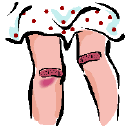When riding a scooter, eventually you'll have an accident of sorts. It may be due to a tire blow out, a car turning left in
front of you , or even your foot slipping out from under you at a oily stoplight. Quality protective gear goes a long way
toward saving your skin and bones. Yet, even the best plans can go awry. When they do, be prepared with a handy first aid
kit.
Each time I see my E.R. Nurse friend, Chudu, I ask him about any gory details he may have from the hospital. Recently, I asked
him for advice on what to pack in my onboard first aid kit. Thanks to Chudu for his assistance with this list. (By the way,
ladies...he's got a sweet GS and a fancy glitter rally and he's single!)
First thing...don't buy a first aid kit from the drugstore. They are better for camping when you might get a fish hook in
your foot or a splinter in your finger. It is better to assemble your own kit with scootering specifically in mind.
No matter how fast you are going when you crash, your main enemy will be road rash-- stinging abrasions that will make your
life miserable. It is important to keep them clean and covered. Use Betodine to clean them and you can cover them with
Gauze. Chudu recommends the rolled gauze because it is most versatile. You can cut the size you need and even use it
as a sling if needed. Another useful item to have is a topical antibiotic such as Neosporin. You can buy such ointments
in flat packets which are easy to store in your kit. One item I found very useful when I had my accident was Adaptec
which is a thin mesh covered in petroleum jelly. It forms a barrier between your skin and the gauze, but allows air to get
through. It makes the removal of gauze much easier!
Tylenol or Motrin is a good item to have as it controls pain and swelling. Just make sure your "patient" can take such medication
before administering it.
One item which is of utmost importance is a good quality pair of medical scissors. They are sharp but have blunt ends
(like the scissors you used in kindergarten, but MUCH sharper. These are indispensable for cutting bandages, clothing, even
cardboard if you need to fashion a splint.
Some final items to consider: amonia salts to revive someone who may have fainted; a cell phone (just in case
it is more serious than your kit can handle). It is also important to know the location of local hospitals and to know your
route so you can direct an ambulance.
With luck, you'll never have to use your kit. But if you do, a well-prepared kit can really make a difference.






